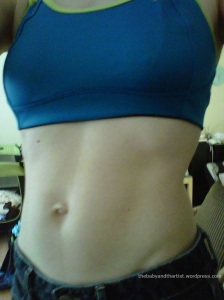Since giving birth, I have a new appreciation for my body. My body is awesome in the truest sense of the word. I have embraced the many stages and changes that evolve out of pregnancy and see them as positive. The focus for me, has been on the beauty of carrying life, not on returning to a pre-pregnancy body. Margaret Lazarus’ documentary film entitled “Birth Markings” speaks to these ideas. Her documentary features many different women speaking about their own postpartum bellies which acts as a physical metaphor and reminder of the transformative power of birth.
After giving birth to little M, my body continued its metamorphosis as my breasts swelled with milk (so that is what I would look like with implants!) while my uterus slowly shrank back to its original size. As the weeks continued on, I was able to fit back into my old pre-pregnancy jeans and my little postpartum tummy gave way to a flattish, slightly squishy looking stomach.
My focus, especially during the first couple of months was to build an ample milk supply. I accomplished this by nursing on demand, keeping my baby close to me, eating well and drinking plenty of water. I felt no rush to return to my fitness class, walking in the fresh air with my baby snuggled in the carrier was the perfect form of exercise in those early weeks. I think it also helped that I saw the first year as a grace period for my body. Looking back in my journal, I see that I returned to my post-natal fitness class when little M was two months old.
Then, just prior to a year my body was “back to normal,” which had a lot to do with: breastfeeding and babywearing, a little circuit training (when I had/have time), some jogging and a wholesome diet. I am still not at my peak fitness level, but that will come in time, besides I am still breastfeeding.
In each of our own [pre or post baby body] journeys I think it is important to take time to think about or meditate on the beauty and miracle of birth. By doing so, one can help cultivate a healthy attitude and respect towards one’s own body and essentially life itself.
In truth, I like the changes that have happened to my body because they remind me that I have carried life. When I see my drooped belly button I remember my pregnancy, little M’s birth and what this has meant to me. And in the two to three months that followed giving birth, I saw my postpartum bump as a sweet reminder of my rebirth as a mother. Whether you have stretch marks, loose skin or not, I hope that all mothers reading this, will appreciate what an honour it truly is.



